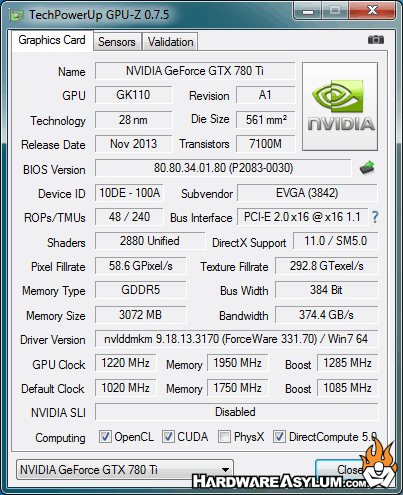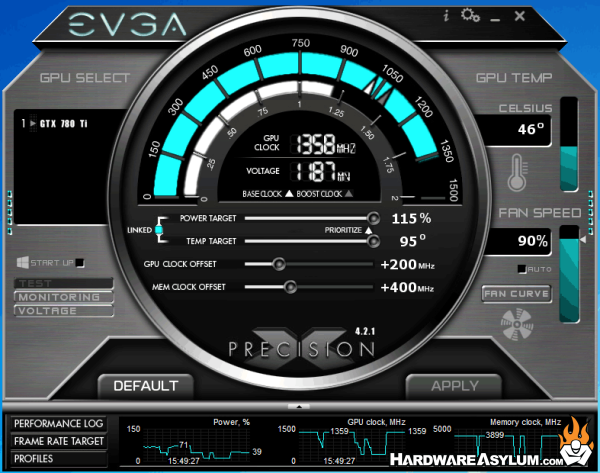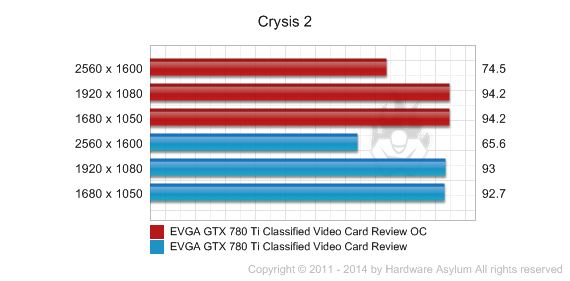EVGA GTX 780 Ti Classified Video Card Review
Author: Dennis GarciaOverclocking
As we eluded there are two reasons to buy an EVGA Classified video card and arguably the most important of them is overclocking. The larger VRM is the driving factor behind this decision as it will increase stability and power delivery to the GPU and allow for higher overclocks. Without it there is a chance you can quickly overpower the circuits and basically burn up the card assuming OCP doesn't kick in first.
Overclocking the Kepler is a little different from previous generation GPUs since you must contend with a non-adjustable Boost Clock. NVidia Boost 2.0 is a form of dynamic overclocking that is determined either by GPU temperature or a predetermined power target. Assuming your GPU is below the programmed temperature the clock speed will scale until it consumes enough power to trip the power target. For these tests we first set out using the stock (position 2) BIOS and quickly discovered that the card would max out at around 1240Mhz. We say around because in certain benchmarks we could run 1340Mhz and in others we had the clocks dialed back. Voltage adjustments were ineffective and actually caused the card to throttle under load so, we needed to do something a little more drastic.
As we have mentioned the GTX 780 Ti Classified is basically identical to the EVGA GTX 780 Classified and finding a modded BIOS is pretty easy with a little searching. The first one we found did a number of things such as raising the power target and removing the boost functionality. Sadly the BIOS didn’t help our overclock and the lack of a boost clock also made voltage tweaking a little more difficult. The second BIOS worked great and didn’t mess with the boost feature or power target but appeared to fool the card in thinking it was drawing less power than it really was.


After some tweaking and tuning we settled on a monster overclock of 1358Mhz Core and 1950Mhz Memory. (+200 / +400 respectively). To enable this overclock the power target was increased to 115% (using the secondary BIOS) along with a slight voltage bump from a software based GTX voltage tool.
With the modded BIOS this GPU would run Firestrike Extreme in excess of 1400Mhz but appeared to be too much for the ACX cooling solutions as it would randomly fail shortly after starting.
As you can see with the new BIOS we are running 1358Mhz and at that speed PrecisionX is only reporting 71% power usage. In reality we suspect the card is pulling over twice that but given the larger VRM the card can easily handle the power demands.




This is by far one of the best video cards we have ever used especially given the performance results using nothing more than the EVGA ACX cooling solution and a slight voltage bump. Overall we are extremely pleased with our results and yet, a sad that we couldn't hit 1400Mhz on air but, that is why we have LN2. Keep in mind that overclocking is not guaranteed so your results may vary.
A word of caution when using modded BIOS images
Under normal circumstances a slightly tweaked BIOS image will do simple things like raising default clock speeds or adjust your fan profile. But, they can also really damage your equipment by setting voltages beyond the safe limits and/or allow “you” to set them higher than they should be. We actually had a fairly good experience with our sampled images and watched as the card would increase the core voltage when needed and generally higher than expected overclocks. The downside to this was stability, for instance if a benchmark would crash such that we needed to reboot the clockspeeds and voltage settings would not reset causing a BSOD at the desktop. A power cycle resolved this problem but is not something we expected to be a problem nor was it an issue using the stock image.

